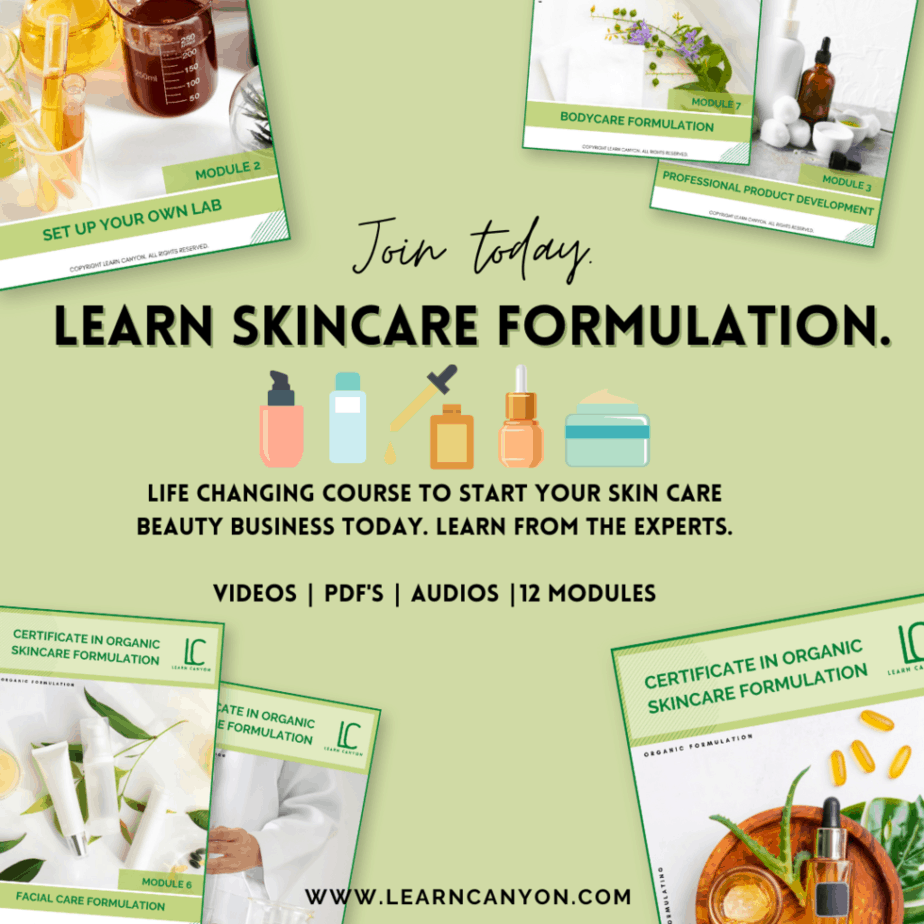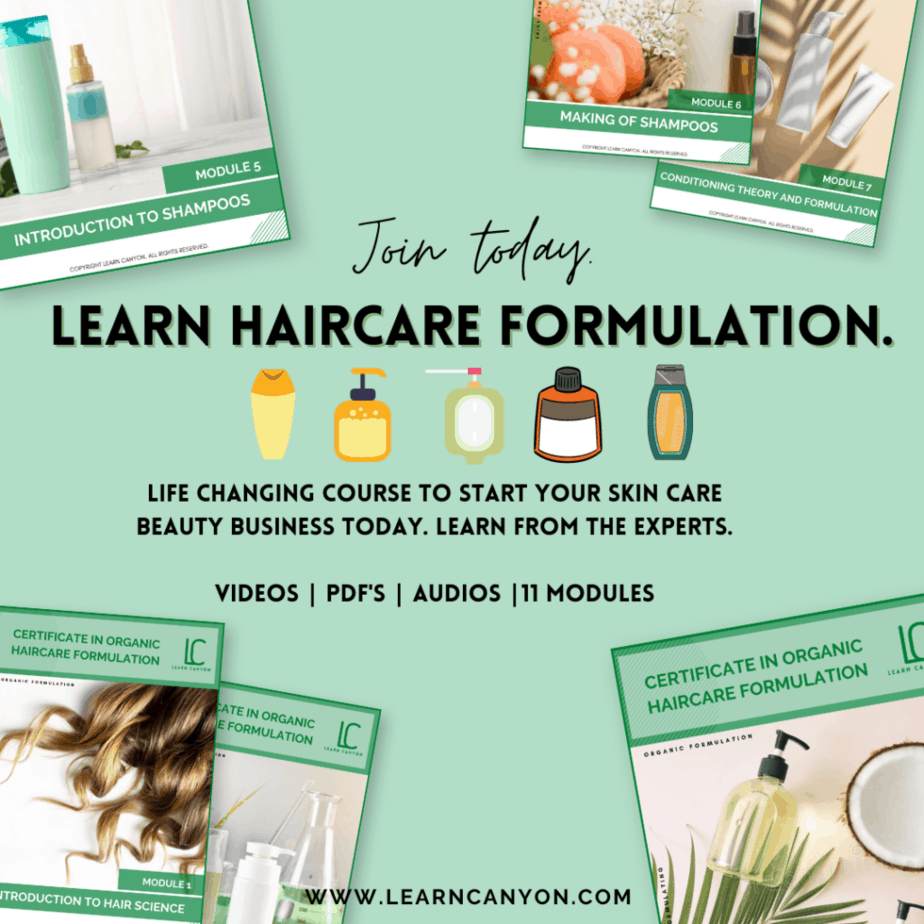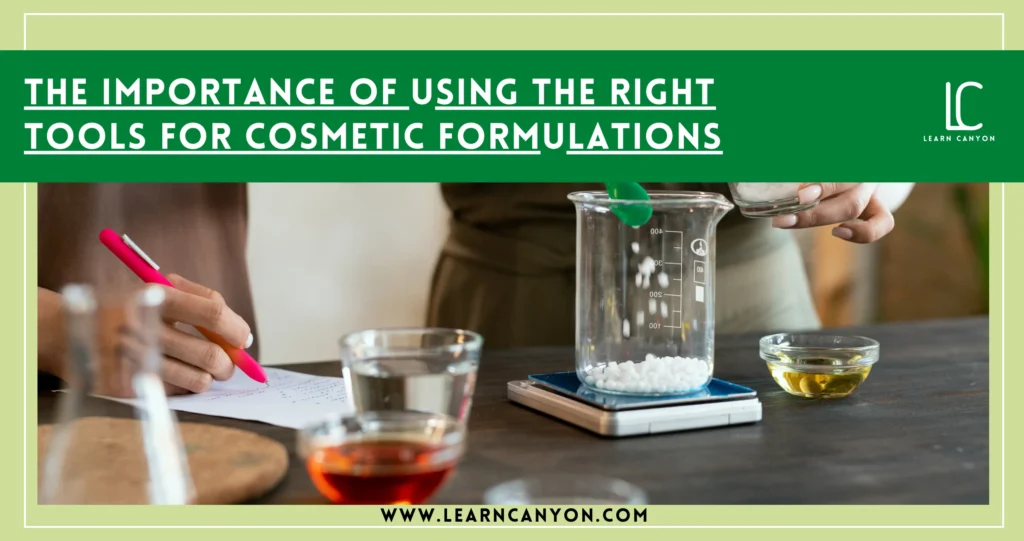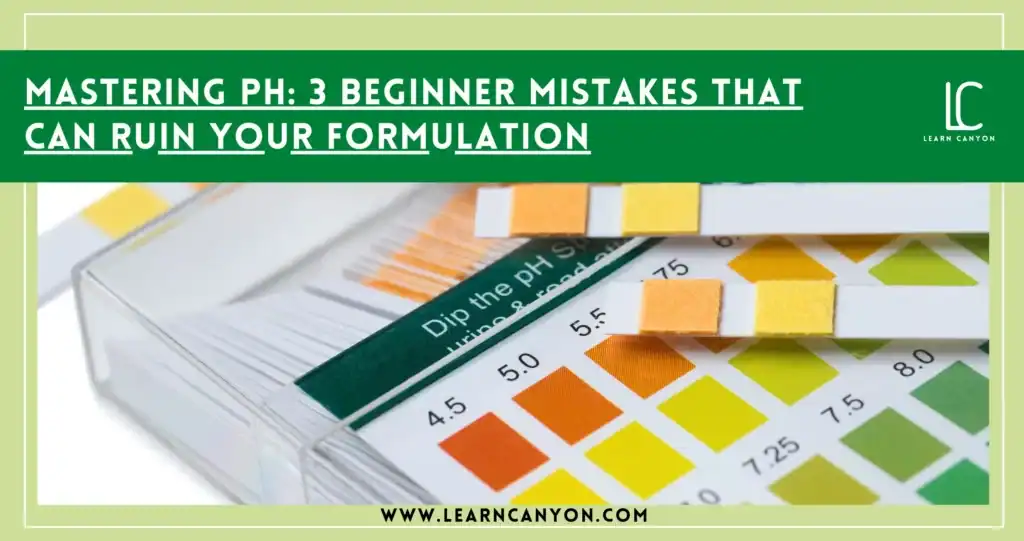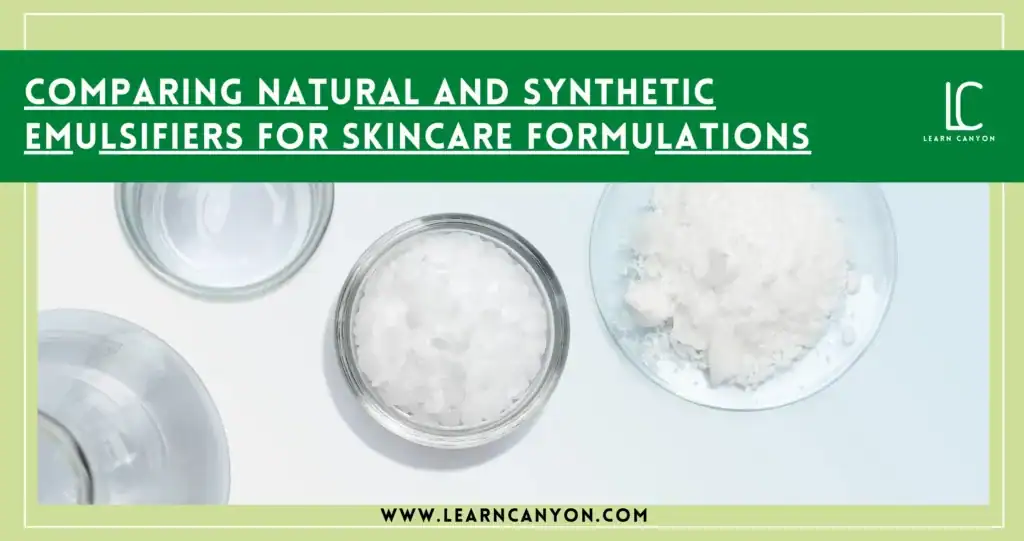Let’s be honest – as cosmetic formulators, we often get tempted to dive straight into experimenting with new ingredients, mixing, and creating without giving much thought to the tools we’re using.
But here’s the thing: the tools we choose can make or break our formulations. Imagine spending hours crafting the perfect cream only to find it separates because your mixing wasn’t uniform. Frustrating, right?
Using the right tools is more than just a professional standard, it’s about ensuring precision, consistency, and safety in every batch we create. Whether it’s a pH meter to get that perfect balance or a homogenizer for a silky emulsion, having the right equipment is like having a trusty partner in your formulation journey.
So, let’s talk about why these tools are absolutely non-negotiable and how they can transform your products from “just okay” to absolutely luxurious!
Why Tools Matter in Cosmetic Formulation
Let’s talk about why the right tools are the unsung heroes of cosmetic formulation. Imagine trying to bake a cake without measuring cups or using a whisk when you really need a stand mixer. You might get something edible, but it’s not going to be that Instagram-worthy dessert you were dreaming of. The same applies to making cosmetics!
First off, precision is key. Whether you’re adding 1% of a preservative or weighing out your oils and butters, guesswork just won’t cut it. A high-quality digital scale ensures every ingredient is measured to the gram (or even milligram), which is critical for both product performance and safety.
Then there’s consistency. If you’ve ever had a lotion that felt grainy or a serum that separated, chances are it’s because of improper mixing. Tools like immersion blenders or homogenizers are your best friends when it comes to creating smooth, stable emulsions. They don’t just mix – they perfectly combine.
And let’s not forget about hygiene. Using clean, sterilized tools isn’t just about being professional; it’s about protecting your customers and your reputation. Contaminated tools can introduce microbes into your formulations, which is a disaster waiting to happen.
The bottom line? The right tools don’t just make your job easier; they elevate the quality of your products, ensure safety, and make sure your formulations stand out in a crowded market. After all, if you’re putting so much effort into crafting that dream serum or buttery-soft lotion, don’t let subpar tools ruin the magic!
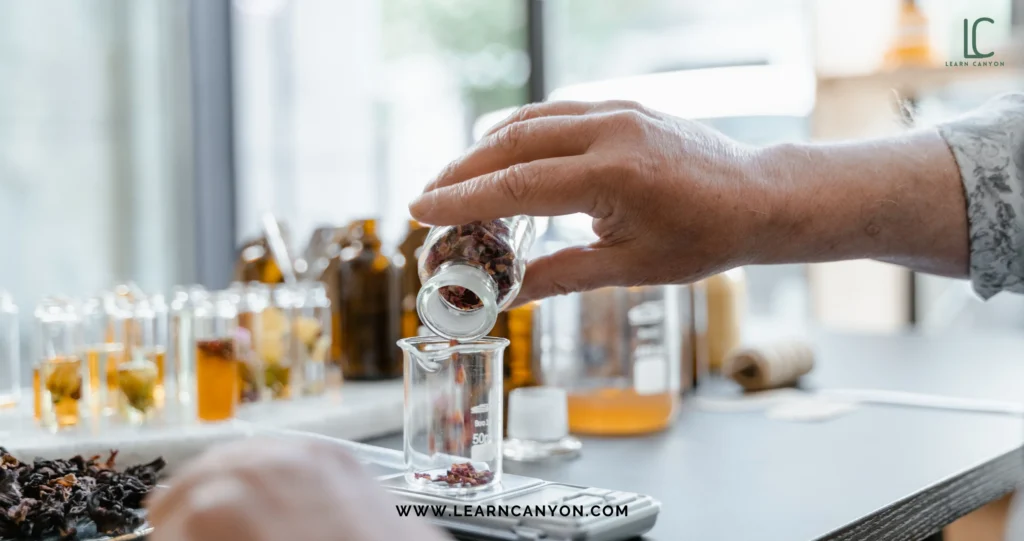
Key Tools for Cosmetic Formulators
Alright, let’s get into the real MVPs of our formulation journey – the tools. If you’re anything like me, you know that having the right equipment not only makes life easier but also takes your products to the next level. So, let’s break it down and chat about the essentials every cosmetic formulator should have in their arsenal.
1. Measuring Tools
Let’s start with the basics. A good digital scale is non-negotiable. Forget about eyeballing ingredients – we’re creating cosmetics, not cooking pasta! You need a scale that’s precise to at least 0.01 grams for those tiny but crucial percentages. And yes, measuring spoons and cups can be helpful, but trust me, nothing beats the accuracy of a proper scale.
2. Mixing Tools
Mixing is where the magic happens! For smaller batches, a spatula and mixing rod work wonders. But if you’re serious about getting those creamy lotions or smooth serums, you’ll want to invest in an immersion blender or, better yet, a homogenizer. These tools don’t just mix – they emulsify like a dream, creating that professional, stable texture we all strive for.
3. Heat and Cooling Tools
Whether you’re melting butters or heating your oil and water phases, a double boiler or a water bath is your go-to. And don’t underestimate the power of proper cooling. Cooling racks or even an ice bath can help set your products at just the right consistency.
4. Packaging Tools
You know that moment when you’re trying to pour your lotion into a tiny bottle and it ends up everywhere but inside? Avoid that mess with funnels, syringes, and pipettes. These are lifesavers for clean and precise filling.
5. Testing Tools
This is where you channel your inner scientist. A pH meter is a must-have for making sure your formulations are skin-friendly and compliant. And if you’re working with emulsions, refractometers can come in handy to test water content or stability.
6. Sterilization Tools
Don’t forget about hygiene! A simple alcohol spray or UV sterilizer can make a world of difference. Clean tools equal safe, professional products.
Pro Tip: Always choose tools that are easy to clean and made from durable, cosmetic-grade materials. Trust me, they’ll save you a ton of time and frustration in the long run.
So, there you have it – the key players that will turn your formulation process from stressful to seamless. With the right tools in your kit, you’re already halfway to creating products that are not only effective but also a joy to make!
Benefits of Using the Right Tools
Let’s get real – using the right tools isn’t just about looking professional in your workspace (although, let’s admit, a well-equipped setup does feel pretty satisfying!). It’s about elevating your entire formulation game. Let me walk you through the why because once you see the benefits, you’ll never want to work with the wrong tools again.
1. Professional Results Every Time
You know that silky, luxurious feel you love in high-end products? That’s not a happy accident – it’s precision. Using the right tools, like a good homogenizer, ensures that your emulsions are stable, your textures are flawless, and your final product feels like it belongs on a store shelf (or in a luxury spa).
2. Time-Saving Efficiency
We’ve all been there – trying to manually mix something for ages, only to realize it’s still not smooth. The right tools cut your formulation time in half, if not more. Imagine whipping up a perfectly blended lotion in minutes instead of wrestling with it for hours. Sounds dreamy, right?
3. Fewer Errors, Less Waste
Let’s talk about the heartbreak of wasted ingredients. Using an accurate scale or pH meter eliminates guesswork and ensures your formulation is spot-on. No more throwing away batches because something was “off.”
4. Consistency Across Batches
If you’ve ever had a product turn out perfect one time and a total flop the next, you’ll appreciate this one. The right tools help you maintain consistency, so every batch feels and performs exactly the same. It’s what separates DIY hobbyists from pro-level formulators.
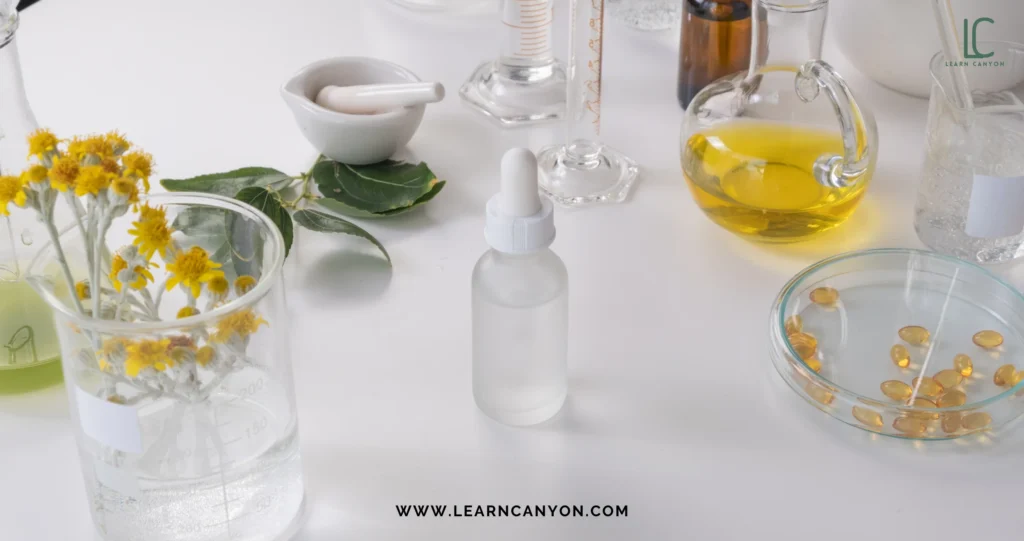
5. Improved Product Stability
Stability is everything. Nobody wants a lotion that separates after a week or a serum that loses its potency. Proper mixing, measuring, and pH testing tools help ensure your product stays stable and effective for its entire shelf life.
6. Elevated Confidence and Creativity
Here’s the thing – when you know you’re working with the right tools, it gives you the confidence to experiment and push boundaries. Want to try that tricky water-in-oil emulsion or formulate a complex serum? With the right equipment, you’ll feel ready to tackle anything.
Pro Tip: The right tools don’t have to be the fanciest or most expensive. Start with the essentials and upgrade as you grow. Even simple, high-quality tools can make a world of difference.
At the end of the day, investing in good tools is an investment in yourself and your craft. With them by your side, you’re not just making products – you’re creating magic that people will keep coming back for!
Common Mistakes When Choosing Tools
Let’s have a little heart-to-heart about some mistakes we’ve all made (or are tempted to make) when picking tools for our formulations. Trust me, I’ve been there, done that, and learned a few lessons the hard way. Here are some common missteps and how you can avoid them.
1. Using Kitchen or DIY Tools Instead of Cosmetic-Grade Ones
We all start somewhere, but let me just say it: your kitchen whisk and measuring spoons are NOT made for cosmetic formulations. They’re fine for whipping up a cake but not for creating stable emulsions or precise measurements. Using the wrong tools can lead to inconsistent products and even contamination. Invest in tools designed for cosmetic work – your formulations (and your clients!) will thank you.
2. Skimping on Accuracy
Here’s a classic rookie move: using a scale that only measures to the nearest gram when your formula calls for 0.5 grams of an active. That little error might not seem like much, but it can completely throw off your product’s efficacy or stability. A precise scale is a must-have – don’t cut corners here!
3. Neglecting Sterilization
Let’s talk about hygiene. Using tools that aren’t properly cleaned or sterilized can introduce bacteria and ruin your batch. And no, a quick rinse under water doesn’t count as sterilization! Always have alcohol spray or a UV sterilizer handy to keep your tools squeaky clean and microbiome-friendly.
4. Choosing the Wrong Materials
Not all tools are created equal, especially when it comes to the materials they’re made of. Plastic tools, for example, can sometimes absorb or react with certain ingredients. Stainless steel or glass is usually a safer bet for cosmetic formulations. They’re durable, non-reactive, and easier to clean.
5. Overlooking Maintenance and Durability
Buying tools is just the first step – keeping them in top shape is where the real work begins. I’ve seen perfectly good pH meters ruined because someone didn’t clean the probe after use or forgot to store it in the proper solution. Take care of your tools, and they’ll take care of you.
6. Buying Too Much Too Soon
This one’s a bit controversial, but hear me out. It’s easy to get carried away and buy every fancy gadget you see. But do you really need that high-end homogenizer if you’re just starting out with small batches? Start with the essentials and gradually expand your toolkit as your needs grow. Trust me, your wallet will appreciate it.
Pro Tip: Do your research before investing in tools. Read reviews, ask other formulators for recommendations, and think about what you actually need for the products you’re creating.
At the end of the day, your tools are an extension of your skills. Choosing the right ones – and taking care of them – will set you up for success, save you from frustration, and make your formulations shine. And hey, we’re all learning here, so don’t be too hard on yourself if you’ve made a few of these mistakes. Just think of it as part of the journey!
How to Choose the Right Tools
Alright, let’s talk about how to pick the perfect tools for your cosmetic formulation journey. It’s easy to get overwhelmed with all the shiny gadgets and fancy equipment out there, but trust me – it doesn’t have to be complicated. Here’s how I, as a fellow formulator, approach choosing the right tools.
1. Start with the Basics
You don’t need a full lab setup right away. Begin with the essentials: a precise digital scale, a good spatula, a mixing bowl, and a pH meter. These are your foundation tools – the ones you’ll use in almost every formula. Once you’ve mastered these, you can gradually upgrade and add more specialized equipment.
2. Think About Your Formulation Goals
Ask yourself: what products do you want to make? If you’re focused on emulsions like creams or lotions, investing in a handheld homogenizer is a game-changer. If you’re leaning toward serums or toners, pipettes and small funnels are a must. Tailor your toolkit to your formulations – one size does NOT fit all.
3. Prioritize Precision and Quality
This one’s non-negotiable. Your scale should measure to at least 0.01 grams for accuracy, and your pH meter should be reliable and easy to calibrate. Cheap tools might save you money upfront, but they often lead to frustration and wasted ingredients. Trust me, it’s worth spending a bit more for tools that get the job done right.
4. Choose Materials Wisely
Plastic tools might seem convenient, but they can sometimes absorb oils or react with certain ingredients. Stainless steel and glass are my go-to materials – they’re durable, easy to clean, and don’t interact with your formulations. Plus, they just feel more professional, don’t they?
5. Think About Scale
Are you formulating for fun, small-batch sales, or full-scale production? Your tool choices will depend on your needs. For example, a handheld immersion blender works great for small batches, but if you’re scaling up, you might need a larger homogenizer or industrial mixing equipment.
6. Don’t Forget About Maintenance
It’s not just about buying the tools – it’s about keeping them in good condition. Look for tools that are easy to clean and maintain. For example, a pH meter with a replaceable probe or a homogenizer with detachable parts will save you headaches in the long run.
7. Budget Smartly
If you’re just starting out, focus on the essentials and save the splurges for later. But when you do splurge, make it count. For example, a high-quality pH meter or scale is worth every penny because it impacts every product you make.
Pro Tip: Join formulator groups or communities – we love sharing tips on the best tools and where to find them! Sometimes, you can even find hidden gems or affordable alternatives that aren’t widely advertised.
8. Test Before You Commit
Whenever possible, try before you buy. Whether it’s attending a workshop or borrowing from a fellow formulator, getting hands-on experience with a tool can help you decide if it’s worth adding to your kit.
Choosing the right tools is like building a team – each one plays a specific role in helping you create safe, effective, and professional products. So, take your time, do your research, and invest in tools that align with your vision. Your future self (and your flawless products) will thank you!
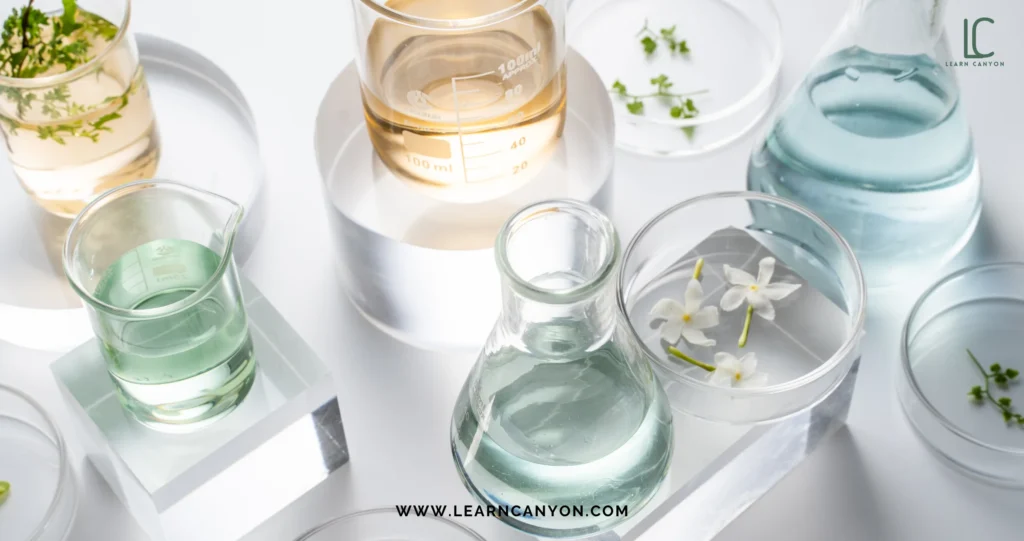
Building Your Toolkit on a Budget
Let’s face it – building your cosmetic toolkit can feel expensive, especially when you’re just starting out. But trust me, you don’t need to blow your budget to get started. I’ve been there, looking at all the fancy equipment and wondering, “Do I really need this right now?” Spoiler: you don’t need everything at once. Here’s how to build a solid toolkit without breaking the bank.
1. Start with the Must-Haves
Focus on the tools you’ll use in almost every formulation. A reliable digital scale that measures to 0.01 grams should be your first investment – no exceptions here! Next, grab a good-quality pH meter (a bit of a splurge, but worth it). Add in some basic mixing tools like spatulas, a whisk, and a stainless-steel bowl. These essentials will get you up and running.
2. DIY What You Can
Some tools can be creatively DIY’d when you’re starting out. Don’t have a proper double boiler? Use a heatproof glass bowl over a pot of simmering water. Need a mixing tool? A handheld milk frother can work as a budget-friendly substitute for an immersion blender for small batches. You’d be surprised how resourceful you can get!
3. Prioritize Multi-Use Tools
Look for tools that can pull double duty. A small kitchen scale, for example, can measure both your ingredients and your packaging weights. Silicone spatulas work for both mixing and scraping out every last drop of your product. The more versatile the tool, the more value you’ll get for your money.
4. Shop Smart
Before you hit “buy” on that shiny new gadget, do some research. Check online marketplaces, sales, or even second-hand options for high-quality tools at a fraction of the cost. Lab equipment suppliers often have better prices than fancy “cosmetic-grade” retailers, so don’t shy away from checking those out.
5. Invest in Quality Over Quantity
It’s tempting to buy the cheapest option for everything, but some tools (like your scale and pH meter) are worth investing in. A cheap pH meter that breaks after a few uses or gives inconsistent readings will end up costing you more in the long run. Choose quality for your key tools, and save on the rest.
6. Use What You Already Have
Take a look around your home – you probably already own some tools you can repurpose for cosmetic formulation. A regular kitchen thermometer works for tracking your phases, and clean, unused mason jars can serve as mixing or storage containers. Just make sure they’re properly sterilized before use.
7. Build Gradually
You don’t need to buy everything all at once. Start with the basics, and as your formulations get more advanced, add tools to your collection. For example, you might not need a homogenizer right away, but once you start working on emulsions regularly, it’s a game-changer.
8. Ask for Recommendations
If you’re part of a formulation community or group, ask around! Other formulators often have amazing budget-friendly recommendations or even gently used tools they’re willing to part with.
Pro Tip: Keep a wishlist! Jot down the tools you’d like to have someday but don’t need immediately. This way, you can watch for sales or prioritize your purchases as your skills and projects grow.
Building your toolkit on a budget isn’t just about saving money – it’s about being intentional with what you buy and focusing on what will truly serve your needs. Remember, it’s not about having all the tools; it’s about using the ones you have effectively. And trust me, even with a minimalist setup, you can create magic!
So, there you have it! The tools we use in cosmetic formulation aren’t just fancy extras – they’re the backbone of our craft. From precision scales and pH meters to the humble spatula, each tool plays a crucial role in bringing your formulations to life. And let’s not forget, the right tools aren’t just about making the process easier; they’re about delivering safe, consistent, and professional-quality products every single time.
Whether you’re just starting out with a basic setup or dreaming of a fully equipped lab, remember this: it’s not about having everything – it’s about making smart choices and using what you have effectively. Take your time to build your toolkit, invest in quality where it matters, and don’t be afraid to get creative when working on a budget.
At the end of the day, your tools are an extension of your skills and creativity. So, treat them well, choose them wisely, and watch how they transform your formulations. Now, go forth and create some amazing products – I know you’ve got this!


